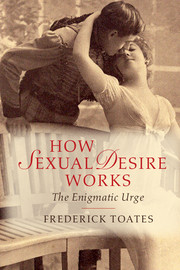Book contents
- Frontmatter
- Dedication
- Contents
- List of figures
- Preface
- One What is enigmatic about sexual desire?
- Two Explaining desire: multiple perspectives
- Three Sexual desire in a broad context
- Four An incentive-based model
- Five Sex and levels of organization
- Six Sexual attraction
- Seven Shades of desire from simple to complex
- Eight Details of the brain and desire
- Nine Arousal
- Ten The consequences of sexual behaviour and associated expectations
- Eleven Sexual familiarity and novelty
- Twelve Inhibition, conflict and temptation
- Thirteen How did sexual desire get here?
- Fourteen Setting the trajectory: link to adult sexuality
- Fifteen Sexual desire in interaction
- Sixteen Representations of sex
- Seventeen Sexual addiction
- Eighteen Variations in desire: general principles
- Nineteen Some forms of desire at the fringes
- Twenty The toxic fusion: violence and sexual desire
- Twenty one Sexually associated (serial) murder
- Twenty two Concluding remarks
- Notes
- References
- Index
Twenty two - Concluding remarks
Published online by Cambridge University Press: 05 October 2014
- Frontmatter
- Dedication
- Contents
- List of figures
- Preface
- One What is enigmatic about sexual desire?
- Two Explaining desire: multiple perspectives
- Three Sexual desire in a broad context
- Four An incentive-based model
- Five Sex and levels of organization
- Six Sexual attraction
- Seven Shades of desire from simple to complex
- Eight Details of the brain and desire
- Nine Arousal
- Ten The consequences of sexual behaviour and associated expectations
- Eleven Sexual familiarity and novelty
- Twelve Inhibition, conflict and temptation
- Thirteen How did sexual desire get here?
- Fourteen Setting the trajectory: link to adult sexuality
- Fifteen Sexual desire in interaction
- Sixteen Representations of sex
- Seventeen Sexual addiction
- Eighteen Variations in desire: general principles
- Nineteen Some forms of desire at the fringes
- Twenty The toxic fusion: violence and sexual desire
- Twenty one Sexually associated (serial) murder
- Twenty two Concluding remarks
- Notes
- References
- Index
Summary
The statements in the lecture were as simple as I could make them. Any statements which have any reference to action must be simple.
(C. P. Snow, 1965, p. 60)It is time to return to the enigma described in Chapter 1: the enormous range of different sexual desires, varying from the all-consuming, through indifference, to aversion and from cases where romantic bonding is a necessary condition for desire to the extremes of callous violence. It is hoped that the book has enabled this diversity to be better understood in terms of the role of differences in various contributory factors, such as:
Genetic differences between people, which can be manifest in terms of different contributions to the structure of brain processes underlying desire, arousal and inhibition, as well as differences in hormone levels.
Different interactions between sexual desire and attachment, drugs and anger/aggression.
Chance events of an arousal-inducing nature experienced early in development.
The occurrence of fear-evoking or disgust-evoking situations at any stage of life.
Different histories of classical conditioning, such that a range of different events can get paired with sexual arousal.
A variety of events that can reinforce or punish expressions of sexual desire and thereby alter that desire.
Differences in sociocultural context.
Given this variety of contributory effects, it is not surprising that there is such a range of different desires both in terms of intensity and their target of attraction. Chapter 2 described a number of common features between sex, feeding and drinking. However, Chapter 4 noted a fundamental difference from feeding and drinking, in that these are both necessary for life and they relate to a regulated state of the body inside and outside the brain. Even given the restraint on variation that is imposed by this regulation, the enormous variety of different appetites for food with associated differences in body weight should be noted. It is suggested that a range of environmental and bodily factors play a role here, some probably similar to those involved in the variations in sexual desire.
- Type
- Chapter
- Information
- How Sexual Desire WorksThe Enigmatic Urge, pp. 442 - 448Publisher: Cambridge University PressPrint publication year: 2014

